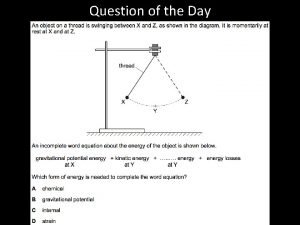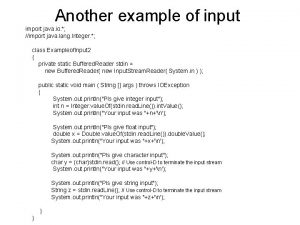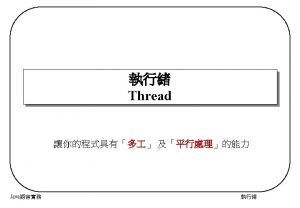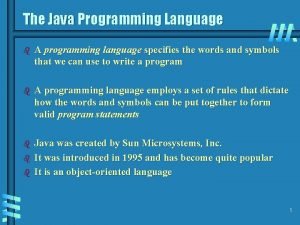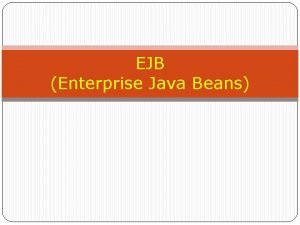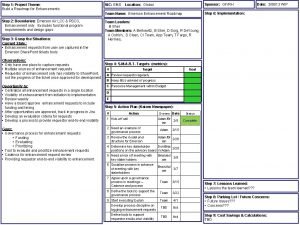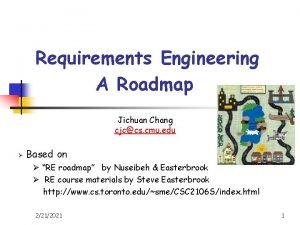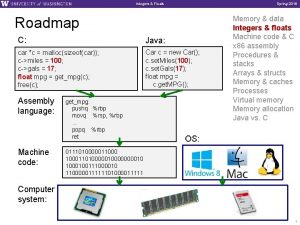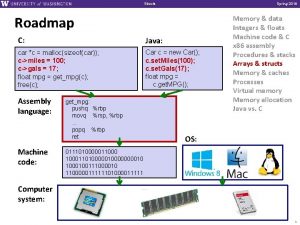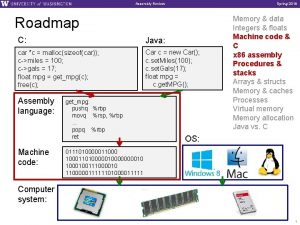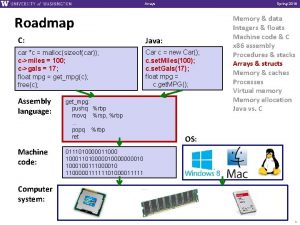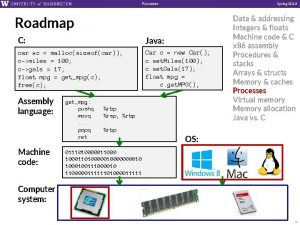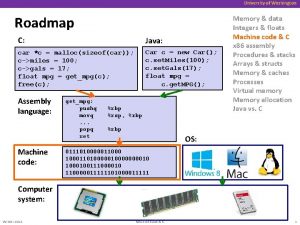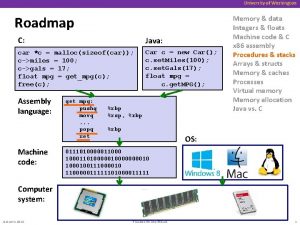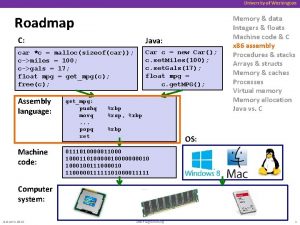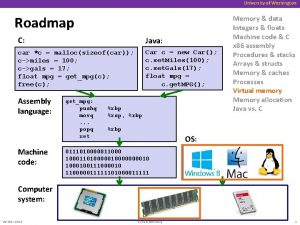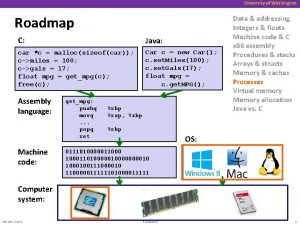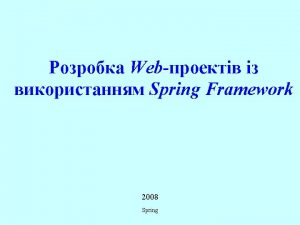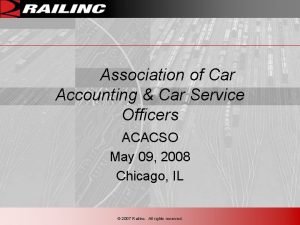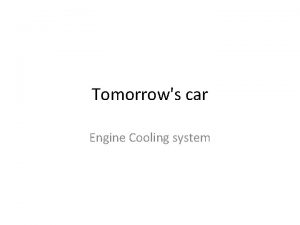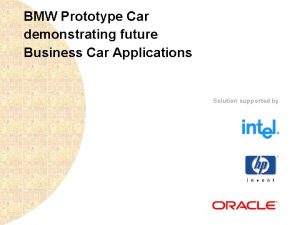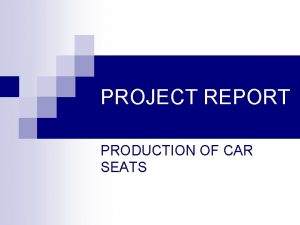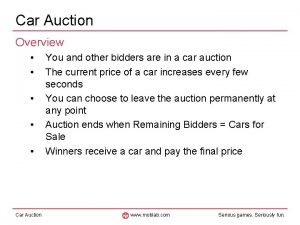Java C Spring 2016 Roadmap C Java car




































- Slides: 36

Java & C Spring 2016 Roadmap C: Java: car *c = malloc(sizeof(car)); c->miles = 100; c->gals = 17; float mpg = get_mpg(c); free(c); Car c = new Car(); c. set. Miles(100); c. set. Gals(17); float mpg = c. get. MPG(); Assembly language: Machine code: get_mpg: pushq movq. . . popq ret %rbp %rsp, %rbp Memory & data Integers & floats Machine code & C x 86 assembly Procedures & stacks Arrays & structs Memory & caches Processes Virtual memory Memory allocation Java vs. C %rbp OS: 011101000001100011010000000010 1000100111000010 110000011111101000011111 Computer system: 1

Java & C Spring 2016 Java vs. C ¢ Reconnecting to Java § Back to CSE 143! § But now you know a lot more about what really happens when we execute programs ¢ We’ve learned about the following items in C; now we’ll see what they look like for Java: § § § Representation of data Pointers / references Casting Function / method calls including dynamic dispatch Runtime environment Translation from high-level code to machine code 2

Java & C Spring 2016 Meta-point to this lecture ¢ None of the data representations we are going to talk about are guaranteed by Java ¢ In fact, the language simply provides an abstraction ¢ We can't easily tell how things are really represented ¢ But it is important to understand an implementation of the lower levels – useful in thinking about your program § just like caching, etc. 3

Java & C Spring 2016 The Other Huge Point ¢ ¢ ¢ CSE 351 has given you a “really different feeling” about what computers do and how programs execute We have occasionally contrasted to Java, but CSE 143 and similar may still feel like, “a different world. ” It’s not – it’s just a higher-level of abstraction § Connect these levels via how-one-could-implement-Java in 351 terms 4

Java & C Spring 2016 Data in Java ¢ Integers, floats, doubles, pointers – same as C § Yes, Java has pointers – they are called ‘references’ – however, Java references are much more constrained than C’s general pointers § Java’s portability-guarantee fixes the sizes of all types § Example: int is 4 bytes in Java regardless of implementation § No unsigned types to avoid conversion pitfalls § ¢ ¢ Added some useful methods in Java 8 (also use bigger signed types) null is typically represented as 0 but “you can’t tell” Much more interesting: § Arrays § Characters and strings § Objects 5

Java & C Spring 2016 Data in Java: Arrays ¢ Arrays § Every element initialized to 0 or null § Length specified in immutable field at start of array (int – 4 bytes) array. length returns value of this field § Since it has this info, what can it do? § int array[5]; // C int[] array = new int[5]; Java C ? ? ? ? ? 0 Java // 4 20 24 5 00 00 00 6

Java & C Spring 2016 Data in Java: Arrays ¢ Arrays § Every element initialized to 0 or null § Length specified in immutable field at start of array (int – 4 bytes) § array. length returns value of this field § Every access triggers a bounds-check Code is added to ensure the index is within bounds § Exception if out-of-bounds § int array[5]; // C int[] array = new int[5]; Java C ? ? ? ? ? 0 Java // 4 20 24 Bounds-checking sounds slow, but: 1. Length field is likely in cache 2. Compiler may store length field in register for loops 3. Compiler may prove that some checks are redundant 5 00 00 00 7

Java & C Spring 2016 Data in Java: Characters & Strings ¢ Characters and strings § Two-byte Unicode instead of ASCII § Represents most of the world’s alphabets § String not bounded by a ‘�’ (null character) § Bounded by hidden length field at beginning of string § All String objects read-only (vs. String. Buffer) the string ‘CSE 351’: C: ASCII 43 53 45 33 35 31 � 0 Java: Unicode 1 4 6 7 16 00 43 00 53 00 45 00 33 00 35 00 31 8

Java & C Spring 2016 Data structures (objects) in Java ¢ Objects are always stored by reference, never stored “inline”. § Include complex data types (arrays, other objects, etc. ) using references C struct rec { int i; int a[3]; struct rec *p; }; Java class Rec { int i; int[] a = new int[3]; Rec p; … } Example of array stored “inline” i a 0 4 0 p 16 4 p 12 20 3 24 0 4 16 9

Java & C Spring 2016 Pointer/reference fields and variables ¢ In C, we have “->” and “. ” for field selection depending on whether we have a pointer to a struct or a struct § (*r). a is so common it becomes r->a ¢ In Java, all non-primitive variables are references to objects § We always use r. a notation § But really follow reference to r with offset to a, just like C’s r->a § So, no Java field needs more than 8 bytes struct rec *r = malloc(. . . ); struct rec r 2; r->i = val; r->a[2] = val; r->p = &r 2; r = new Rec(); r 2 = new Rec(); r. i = val; r. a[2] = val; r. p = r 2; 10

Java & C Spring 2016 Pointers/References ¢ Pointers in C can point to any memory address ¢ References in Java can only point to [the starts of] objects § And can only be dereferenced to access a field or element of tha. Xt object Java class Rec { int i; int[] a = new int[3]; Rec p; } Rec r = new Rec (); some_fn(r. a, 1) // ref, index C struct rec { int i; int a[3]; struct rec *p; }; struct rec * r = malloc(…); some_fn(&(r->a[1])) //ptr r r i a 0 4 i a p 16 24 0 4 X p 12 20 3 … 0 4 16 11

Java & C Spring 2016 Casting in C (example from Lab 5) ¢ We can cast any pointer into any other pointer; just look at the same bits differently struct Block. Info { size_t size. And. Tags; struct Block. Info * next; struct Block. Info * prev; }; typedef struct Block. Info; … int x; Block. Info *b; Block. Info *new. Block; … new. Block = (Block. Info *) ( (char *) b + … s n p 0 8 16 24 s n Cast b into char pointer so that you can add byte offset without scaling x ); Cast back into Block. Info pointer so you can use it as Block. Info struct p x 12

Java & C Spring 2016 Type-safe casting in Java ¢ Can only cast compatible object references class Object { … } // Vehicle v Car c 1 Boat b 1 Vehicle v 1 class Vehicle { int passengers; } class Boat extends Vehicle { int propellers; } class Car extends Vehicle { int wheels; } is a super class of Boat and Car, which are siblings = new Vehicle(); = new Car(); = new Boat(); = new Car(); Vehicle v 2 = v 1; Car c 2 = new Boat(); Car c 3 = new Vehicle(); Boat b 2 = (Boat) v; Car c 4 = (Car) v 2; c 5 = (Car) b 1; 13

Java & C Spring 2016 Type-safe casting in Java ¢ Can only cast compatible object references class Object { … } // Vehicle v Car c 1 Boat b 1 Vehicle v 2 Car c 3 Boat b 2 Car c 4 c 5 class Vehicle { int passengers; } class Boat extends Vehicle { int propellers; } class Car extends Vehicle { int wheels; } is a super class of Boat and Car, which are siblings = new Vehicle(); = new Car(); = new Boat(); // OK, everything needed for Vehicle = new Car(); // is also in Car // OK, v 1 is declared as type Vehicle = v 1; // Compiler error - Incompatible type – elements = new Boat(); // in Car that are not in Boat (classes are siblings = new Vehicle(); // Compiler error - Wrong direction; elements in Car // not in Vehicle (wheels) // Run-time error; Vehicle does not contain = (Boat) v; // all elements in Boat (propellers) How is this // OK, v 2 refers to a Car at runtime = (Car) v 2; implemented/ // Compiler error - Unconvertible types, = (Car) b 1; enforced? 14 // b 1 is declared as type Boat

Java & C Spring 2016 Java objects class Point { double x; double y; Point() { x = 0; y = 0; } boolean same. Place(Point p) { return (x == p. x) && (y == p. y); } fields constructor method } … Point p = new Point (); … creation 15

Java & C Spring 2016 Java objects p Point object header vtable pointer x y vtable for class Point : q code for Point() Point object header ¢ vtable pointer x code for same. Place() y vtable pointer : points to virtual method table § like a jump table for instance (“virtual”) methods plus other class info § one table per class ¢ Object header : GC info, hashing info, lock info, etc. (no size – why? ) 16

Java & C Spring 2016 Java Constructors When we call new : allocate space for object, zero/null fields, and run constructor C pseudo-translation: Java: ¢ Point p = new Point(); p Point* p = calloc(1, sizeof(Point)); p->header =. . . ; p->vtable = &Point_vtable; p->vtable[0](p); Point object header vtable pointer x y vtable for class Point : code for Point() code for same. Place() 17

Java & C Spring 2016 Java Methods ¢ Static methods are just like functions ¢ Instance methods § can refer to this; § have an implicit first parameter for this; and § can be overridden in subclasses ¢ The code to run when calling an instance method (e. g. , p. same. Place(q) ) is chosen at run-time by lookup in the vtable. C pseudo-translation: Java: p->vtable[1 ](p, q); p. same. Place(q); p Point object header vtable pointer x y vtable for class Point : code for Point() code for same. Place() 18

Java & C Spring 2016 Subclassing class 3 DPoint extends Point { double z; boolean same. Place(Point p 2) { return false; } void say. Hi() { System. out. println("hello"); } } ¢ Where does “ z” go? At end of fields of Point § Point fields are always in the same place, so Point code can run on 3 DPoint objects without modification ¢ Where does pointer to code for two new methods go? § No constructor, so use default Point constructor § To override “same. Place ”, use same vtable position § Add new pointer at end of table for new method “say. Hi ” 19

Java & C Spring 2016 Subclassing class 3 DPoint extends Point { double z; boolean same. Place(Point p 2) { return false; } void say. Hi() { System. out. println("hello"); } } z tacked on at end 3 DPoint object header vtable x vtable for 3 DPoint (not Point ) y constructor same. Place z say. Hi Pointer to code for say. Hi Pointer to old code for constructor Pointer to new code for same. Place 20

Java & C Spring 2016 Dynamic dispatch Point object header vtable pointer x Point vtable code for Point’s same. Place() code for Point() 3 DPoint object header y vtable pointer x 3 DPoint vtable y z code for say. Hi() code for 3 DPoint’s same. Place() Java: Point p = ? ? ? ; return p. same. Place (q); C pseudo-translation: // works regardless of what p is return p ->vtable[1 ](p, q); 21

Java & C Spring 2016 That’s the “magic” ¢ In CSE 143, it may have seemed “magic” that an inherited method could call an overridden method § You were tested on this endlessly ¢ The “trick” in the implementation is this part: p->vtable[i]( p, q) § In the body of the pointed-to code, any calls to (other) methods of this will use p->vtable § Dispatch determined by p, not the class that defined a method 22

Java & C Spring 2016 Implementing Programming Languages ¢ Many choices in how to implement programming models ¢ We’ve talked about compilation, can also interpret ¢ Interpreting languages has a long history § Lisp, an early programming language, was interpreted ¢ Interpreters are still in common use: § Python, Javascript, Ruby, Matlab, PHP, Perl, … Interpreter imp. I Your source code Binary executable Interpreter binary Hardware 23

Java & C Spring 2016 An Interpreter is a Program ¢ Execute the source code directly (or something close) ¢ Simpler/no compiler – less translation ¢ More transparent to debug – less translation ¢ ¢ Easier to run on different architectures – runs in a simulated environment that exists only inside the interpreter process § Just port the interpreter Slower and harder to optimize Interpreter imp. I Your source code Interpreter binary 24

Java & C Spring 2016 Interpreter vs. Compiler ¢ An aspect of a language implementation § A language can have multiple implementations § Some might be compilers and other interpreters ¢ “Compiled languages” vs. “Interpreted languages” a misuse of terminology § But very common to hear this § And has some validation in the real world (e. g. , Java. Script vs. C) ¢ Also, as about to see, modern language implementations are often a mix of the two § Compiling to a bytecode language, then interpreting § Doing just-in-time compilation of parts to assembly for performance 25

Java & C Spring 2016 “The JVM” ¢ Java programs are usually run by a Java virtual machine (JVM) § JVMs interpret an intermediate language called Java bytecode § Many JVMs compile bytecode to native machine code § just-in-time (JIT) compilation § Java is sometimes compiled ahead of time (AOT) like C 26

Java & C Spring 2016 Compiling and Running Java ¢ The Java compiler converts Java into Java bytecodes ¢ Java bytecodes are stored in a. class file ¢ To run the Java compiler: § javac Foo. java ¢ To execute the program stored in the bytecodes, Java bytecodes can be interpreted by a program (an interpreter) ¢ For Java, this interpreter is called the Java Virtual Machine ¢ To run the Java virtual machine: § java Foo § This loads the contents of Foo. class and interprets the bytecodes Note: The Java virtual machine is different than the CSE VM running on VMWare. Another use of the word “virtual”! 27

Java & C Spring 2016 Virtual Machine Model Bytecode compiler High-Level Language Program (e. g. Java, C) (e. g. javac Foo. java ) compile time run time Virtual machine (interpreter) (e. g. java Foo ) Ahead-of-time compiler Virtual Machine Language (e. g. Java bytecodes) JIT compiler Native Machine Language (e. g. x 86, MIPS) 28

Java & C Spring 2016 Java bytecode ¢ like assembly code for JVM, but works on all JVMs: hardware-independent ¢ typed (unlike x 86 assembly) ¢ strong JVM protections Holds pointer ‘this’ Other arguments to method Other local variables 0 1 2 3 4 variable table n operand stack constant pool 29

Java & C Spring 2016 Holds pointer ‘this’ Other arguments to method JVM Operand Stack Other local variables machine: 0 1 2 3 4 variable table operand stack ‘i’ stands for integer, ‘a’ for reference, ‘b’ for byte, ‘c’ for char, ‘d’ for double, … bytecode: iload 1 iload 2 iadd istore 3 No registers or stack locations; all operations use operand stack. n constant pool // // // push 1 st argument from table onto stack push 2 nd argument from table onto stack pop top 2 elements from stack, add together, and push result back onto stack pop result and put it into third slot in table compiled to x 86: mov add mov 8(%ebp), %eax 12(%ebp), %edx, %eax, -8(%ebp) 30

Java & C Spring 2016 A Simple Java Method java. lang. String get. Employee. Name() 0 aload 0 // "this" object is stored at 0 in the var table 1 getfield #5 <Field java. lang. String name> // takes 3 bytes // pop an element from top of stack, retrieve its // specified instance field and push it onto stack. // "name" field is the fifth field of the object 4 areturn 0 // Returns object at top of stack 1 aload_0 4 05 00 getfield In the. class file: 2 A B 4 00 05 areturn B 0 http: //en. wikipedia. org/wiki/Java_bytecode_instruction_lis tings 31

Java & C Spring 2016 Class File Format ¢ Every class in Java source code is compiled to its own class file ¢ 10 sections in the Java class file structure: § § § § § ¢ Magic number : 0 x. CAFEBABE (legible hex from James Gosling – Java’s inventor) Version of class file format : the minor and major versions of the class file Constant pool : set of constant values for the class Access flags : for example whether the class is abstract, static, final, etc. This class : The name of the current class Super class : The name of the super class Interfaces : Any interfaces in the class Fields: Any fields in the class Methods: Any methods in the class Attributes: Any attributes of the class (for example, name of source file, etc. ) A. jar file collects together all of the class files needed for the program, plus any additional resources (e. g. images) 32

Java & C Disassembled Java Bytecode javac Employee. javap -c Employee Spring 2016 Compiled from Employee. java class Employee extends java. lang. Object { public Employee(java. lang. String, int); public java. lang. String get. Employee. Name(); public int get. Employee. Number(); } Method Employee(java. lang. String, int) 0 aload_0 1 invokespecial #3 <Method java. lang. Object()> 4 aload_0 5 aload_1 6 putfield #5 <Field java. lang. String name> 9 aload_0 10 iload_2 11 putfield #4 <Field int id. Number> 14 aload_0 15 aload_1 16 iload_2 17 invokespecial #6 <Method void store. Data(java. lang. String, int)> 20 return Method java. lang. String get. Employee. Name() 0 aload_0 1 getfield #5 <Field java. lang. String name> 4 areturn Method int get. Employee. Number() 0 aload_0 1 getfield #4 <Field int id. Number> 4 ireturn Method void store. Data(java. lang. String, int) … 33

Java & C Spring 2016 Other languages for JVMs ¢ JVMs run on so many computers that compilers have been built to translate many other languages to Java bytecode: § § § § § Aspect. J, an aspect-oriented extension of Java Cold. Fusion , a scripting language compiled to Java Clojure, a functional Lisp dialect Groovy, a scripting language Java. FX Script, a scripting language for web apps JRuby, an implementation of Ruby Jython, an implementation of Python Rhino, an implementation of Java. Script Scala, an object-oriented and functional programming language And many others, even including C! 34

Java & C Spring 2016 Microsoft’s C# and. NET Framework ¢ ¢ C# has similar motivations as Java Virtual machine is called the Common Language Runtime; Common Intermediate Language is the bytecode for C# and other languages in the. NET framework 35

Java & C Spring 2016 We made it! ☺ �� �� C: Java: car *c = malloc(sizeof(car)); c->miles = 100; c->gals = 17; float mpg = get_mpg(c); free(c); Car c = new Car(); c. set. Miles(100); c. set. Gals(17); float mpg = c. get. MPG(); Assembly language: Machine code: get_mpg: pushq movq. . . popq ret %rbp %rsp, %rbp Memory & data Integers & floats Machine code & C x 86 assembly Procedures & stacks Arrays & structs Memory & caches Processes Virtual memory Memory allocation Java vs. C %rbp OS: 011101000001100011010000000010 1000100111000010 110000011111101000011111 Computer system: 36
 Qq moves
Qq moves Giduk
Giduk Spring is green summer is bright song
Spring is green summer is bright song Hydraulic suspension
Hydraulic suspension A moving cart slows slightly as it rolls toward a spring
A moving cart slows slightly as it rolls toward a spring Car 2 car communication consortium
Car 2 car communication consortium A 1000 kg car and a 2000 kg car is hoisted the same height
A 1000 kg car and a 2000 kg car is hoisted the same height Mvc
Mvc Java import java.util.*
Java import java.util.* Java import java.util.*
Java import java.util.* Swing vs awt
Swing vs awt Import java.util.scanner;
Import java.util.scanner; Import java.util.*
Import java.util.* Java import java.util.*
Java import java.util.* Import java.util
Import java.util Import java.io.*
Import java.io.* Import java
Import java Java import java.io.*
Java import java.io.* Perbedaan swing dan awt
Perbedaan swing dan awt Import java.awt.* import java.awt.event.*
Import java.awt.* import java.awt.event.* Java interpreter
Java interpreter Ejb javatpoint
Ejb javatpoint Xilinx fpga roadmap
Xilinx fpga roadmap What is a thesis and roadmap
What is a thesis and roadmap Ccna roadmap
Ccna roadmap Roadmap in an essay
Roadmap in an essay Mole road map definition
Mole road map definition Essay roadmap
Essay roadmap Win ccoa
Win ccoa Dlp roadmap
Dlp roadmap Data strategy roadmap template
Data strategy roadmap template Sponsor roadmap
Sponsor roadmap Semiconductor technology roadmap
Semiconductor technology roadmap Semiconductor roadmap
Semiconductor roadmap Strawman plan example
Strawman plan example Jichuan chang
Jichuan chang Sap epm tools
Sap epm tools




